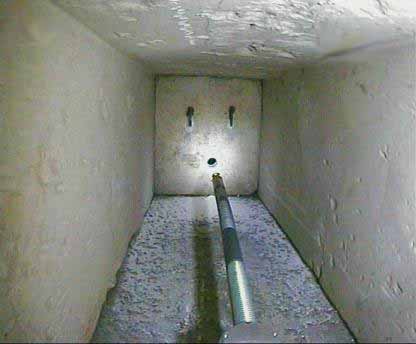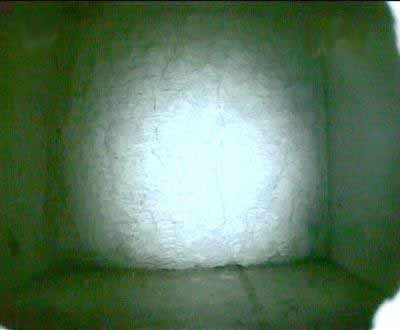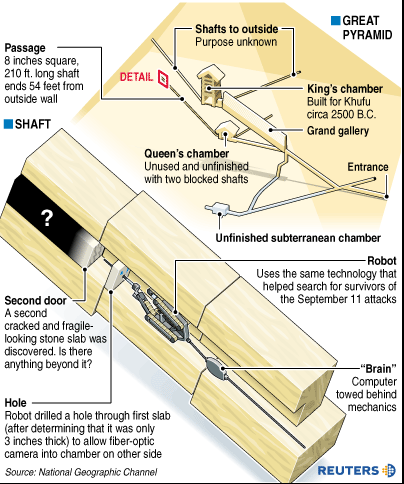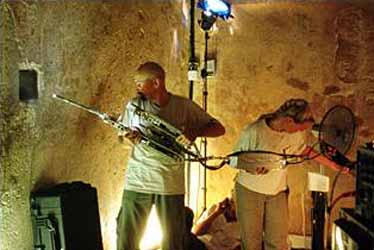




Gantenbrink's Door is a stone block found at the end of a shaft in the Great Pyramid of Cheops. It is most likely actually a dead-end wall, but it resembles an entrance-way due to two ornamental copper fixtures. Some conspiracy theorists have suggested that it is, in fact, a door, and have made wild speculations about what lies on the "other side" and who wants to keep it secret.
In recent years, a New or Alternative Egyptology has evolved theories from a starting point that the pyramids were not tombs at all. These ideas are controversial and largely ridiculed by conventional academic Egyptology.
- Egyptology is the scientific study of Ancient Egypt and Egyptian antiquities and is a regional and thematic branch of the larger disciplines of ancient history and archaeology. A practitioner of the discipline is an Egyptologist.
Alternative Egyptology is a broad set of alternative theories that are evolving into an alternative explanation of certain aspects of Ancient Egypt. Alternative Egyptology theorists are becoming a cohesive group. Alternative Egyptology itself does not represent a single cohesive view. Alternative Egyptology is a branch of historical revisionism.
Egyptologists acknowledge unsolved problems in Egyptology. Some artifacts have been found that appear to use or require 19th or 20th century technology. The precision in apparently machining the granite of the "sarcophagus" in the Great Pyramid exceeds many method available today. Alternative Egyptology emerged initially from alternative explanations of this evidence of ancient technology
.Perhaps the greatest single achievement of conventional Egyptology was at its modern inception in 1822, when Jean-François Champollion announced his general decipherment of the system of Egyptian hieroglyphics for the first time, employing the Rosetta Stone as his primary aid. There is, however, sufficient ambiguity in translation to allow alternative theorists to suggest alternative meanings for many words.
Alternative Egyptology is predicated on acceptance of the concept of Cyclical History -- the belief that technology, government and other aspects of society do not move inexorably forward. Cyclical History assumes that society is fundamentally unstable and that some aspects of history will tend to repeat themselves, and that knowledge has been lost almost as often as it has been gained, over the course of human development.
Alternative theorists note that there is little physical evidence that the pyramids were used as tombs. The great Pharaohs were entombed in the Valley of the Kings and not in the pyramids. The granite box in the Great Pyramid that traditional Egyptology refers to as a sarcophagus bears little resemblance to the sarcophaguses in the Valley of the Kings.
Christopher Dunn's theories, presented in The Giza Power Plant, suggest that the Great Pyramid was designed to collect and focus energy and convert it to microwaves. It does not go as far as to suggest a final use for the collected and converted power. Dunn gained increased recognition when he made what seems to have been the most accurate prediction of what was found beyond Gantenbrink's Door.
On a smaller scale, technologists commonly note the apparent construction in Ancient Egypt of batteries for the production of electricity.
Another important common observation in Alternative Egyptology regards problems with dating. Dr. Robert M. Schoch's work in dating construction of the Sphynx by considering the weathering of the stone in relationship to ancient climatic changes suggests construction dates significantly older than those understood by Egyptologists.
Alternative Egyptology theorists conclude either that there was a previous civilization in Egypt that created certain key artifacts, or that Ancient Egypt as we know it was the successor to an even more ancient civilization.
The shaft is located on the southern side of the Queen's Chamber--another inaccurate name, as there's no evidence it was ever used for Cheops' queen. The stone block is named after robotic engineer Rudolph Gantenbrink, who was hired to install ventilation fans in the pyramid.
In 1993, he convinced the Egyptian government to allow him to send a small robot up the 213-foot shaft for exploration purposes, discovering the wall that would soon bear his name.
Ancient Egyptian Chambers Explored National Geographic - April 4, 2003
Door shuts on pyramid's mysteries BBC - September 2002 -- During the two hour TV special, a robot was placed through a hole drilled in a wall of the Queen's Chamber.
As I predicted for weeks before this event, they would find nothing but a continuation of the shaft. The Great Pyramid does not contain sarcophagi - statues - inscriptions by creators, other than those placed there by humans in recent times.
Realities Beyond the Recent Robotic Probe of the Queen's Chamber JJ Hurtak -- "One has to wonder at the reasons for these shafts in the Great Pyramid. The initial theory was that they could have permitted air currents for laborers working beneath thousands of tons of stone. A different theory maintains that the shafts enhanced the ritual intoning of musical sounds; sounds passing over the shaft lip would produce what musicologists call the "Helmholz Effect" (named after German physicist Herman Helmholz), their natural acoustic frequency amplified to coincide with an excitation frequency."




0 comments:
Post a Comment